Business News Daily provides resources, advice and product reviews to drive business growth. Our mission is to equip business owners with the knowledge and confidence to make informed decisions. As part of that, we recommend products and services for their success.
We collaborate with business-to-business vendors, connecting them with potential buyers. In some cases, we earn commissions when sales are made through our referrals. These financial relationships support our content but do not dictate our recommendations. Our editorial team independently evaluates products based on thousands of hours of research. We are committed to providing trustworthy advice for businesses. Learn more about our full process and see who our partners are here.
9 Ways to Use ChatGPT for Small Business
ChatGPT is making big waves, but could it offer real benefits to your small business?

Table of Contents
By now, everyone has heard of ChatGPT and how it will either drive everyone out of work or make their work-life balance easier and more fulfilling. Seemingly overnight, a cottage industry has sprung up around ChatGPT and similar chatbots. On the back of these chatbots, a suite of connective tools which promised increased efficiency has also risen.
Despite the promises, there’s plenty to shake out regarding AI in general and ChatGPT in particular. These tools are still under development, and AI is a new and rapidly growing field. Still, businesses can wring huge benefits out of finding intelligent ways to use these tools. We’ve put together the following primer to help SMBs learn more about ChatGPT and how to use the tool to its fullest potential.
What is ChatGPT?
ChatGPT is a generative AI chatbot — a type of program that can generate unique answers in response to user input — developed by the company OpenAI. To put it simply, ChatGPT and its successor, GPT-4, are chatbots that can develop responses to almost any written prompt. Chatbots use advanced machine learning techniques to “learn” language from huge amounts of data. OpenAI trained its chatbots on textual data from the internet, including books, blogs, news articles and internet comment boards.
This huge amount of data, along with AI research techniques, allows ChatGPT to generate responses in a multitude of styles on a wide range of topics. When using ChatGPT, though, it is best to employ a human editor to fact-check and proofread the copy it generates — the chatbot is not always 100 percent accurate, so its responses need a human touch before publication.
Is ChatGPT free?
The basic tier of ChatGPT is free to all users. However, ChatGPT Plus costs $20 per month. For the average user, the base version of ChatGPT is more than enough. However, ChatGPT Plus promises access to the tool even when demand is high. Additionally, ChatGPT Plus delivers faster response speeds and priority access to new features.
The main draw of ChatGPT Plus is the underlying technology. While ChatGPT uses GPT 3.5, ChatGPT Plus uses GPT-4. This enhanced version of OpenAI’s GPT software boasts several upgrades over GPT 3.5, such as better problem-solving skills and a wider range of general knowledge.
For developers, OpenAI also offers API access to ChatGPT and GPT-4. Costs for API access are dependent upon which chatbot you want to connect to and upon usage.
9 ways ChatGPT can benefit small businesses
ChatGPT has a wide range of uses for small businesses. Ultimately, the usage is limited by business need, familiarity with the tool and imagination. It can be strange to think of outsourcing more advanced tasks to a piece of software. Once small businesses get over that hump, though, they may find that ChatGPT can offer a range of benefits.
The following are some ideas about ways to use this tool. Please note all of these examples are left at a basic level. ChatGPT can produce more advanced responses based on user input.
1. Generating summaries
ChatGPT can be effective at generating textual summaries, such as drafting up a report based on meeting notes, summarizing an article, creating executive summaries, or converting research notes into a bluff. Note, however, that ChatGPT has an input limit of a set number of “tokens,” which somewhat corresponds to a character or word limit. Some words use up more tokens, and some use less, so you may need to break up your input into sections to create a full summary.
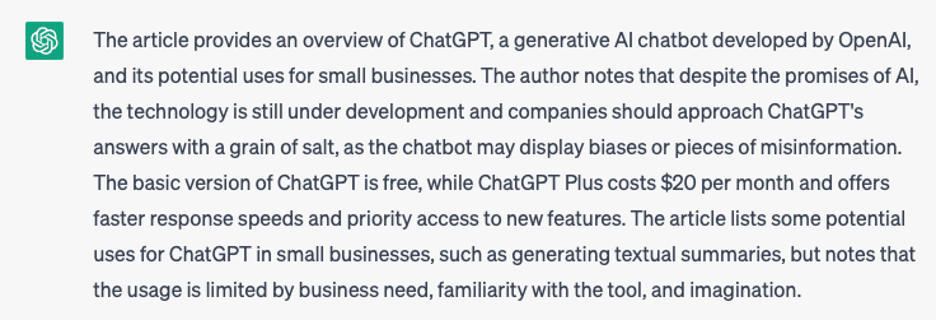
A screenshot of a ChatGPT summary of this article up to this point. Source: ChatGPT
2. Creating outlines
ChatGPT can suggest outlines based on the subject you provide. This can help focus ideas on a certain topic and increase efficiency. While the outlines may be overly expansive for your particular needs, they provide an easy starting point.
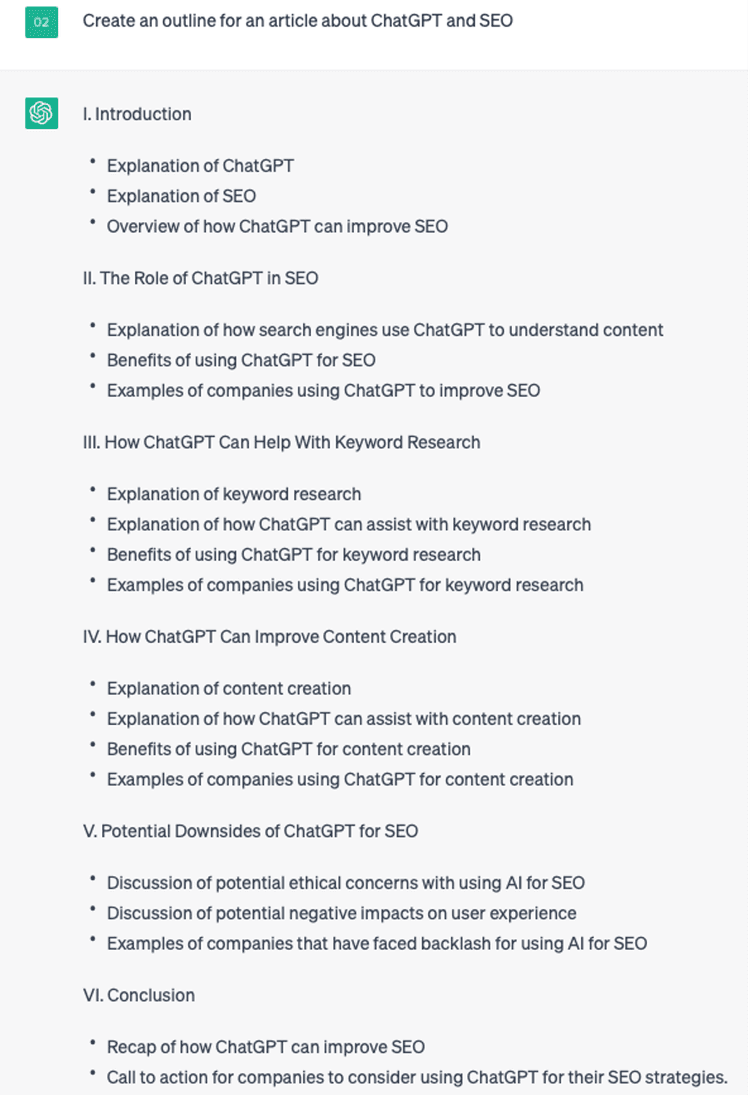
A screenshot of an article outline ChatGPT generated. Source: ChatGPT
3. Generating SEO-friendly keywords for a topic
Identifying SEO-friendly keywords for a subject is an integral part of SEO strategy. ChatGPT’s vast amounts of training data gives it insight into what words can work for any subject, which helps boost a business’ search engine rankings.
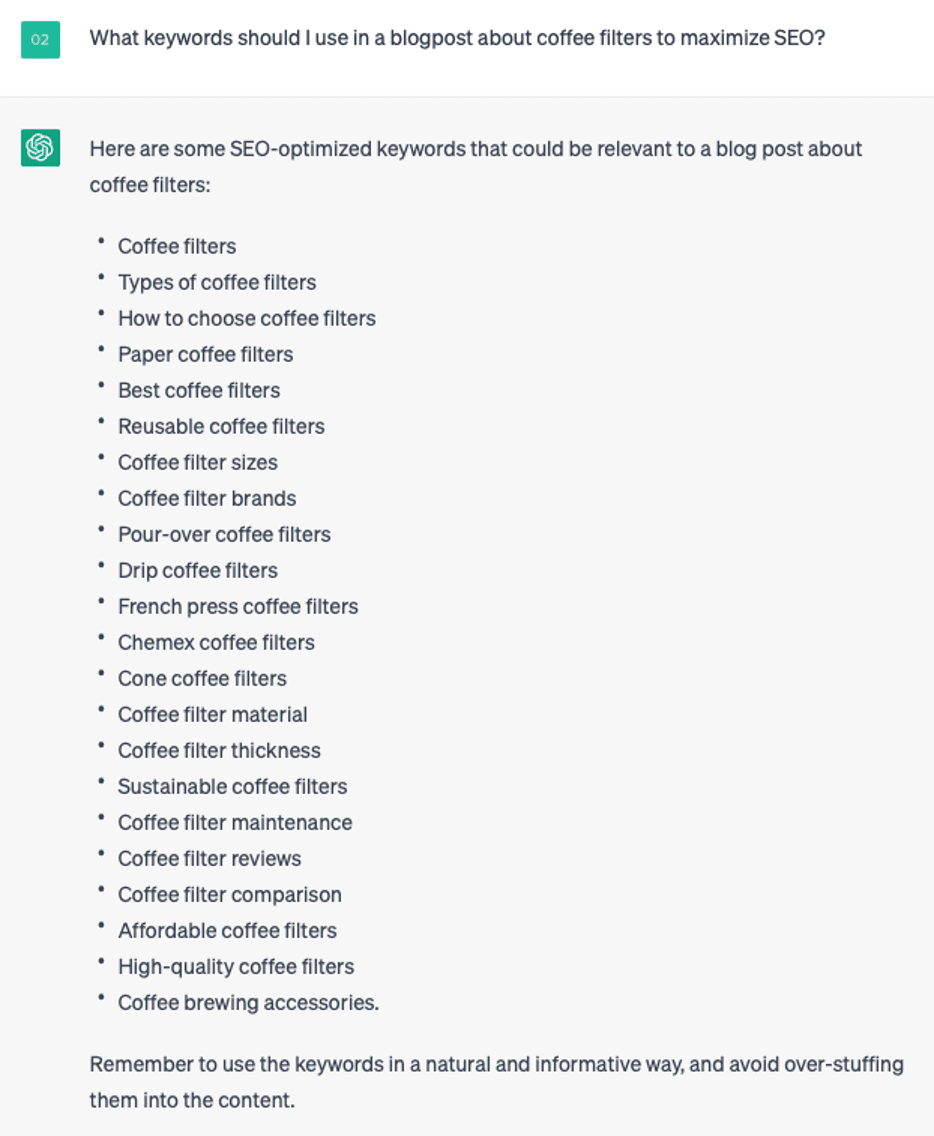
A screenshot of generated SEO keywords. Source: ChatGPT
4. Brainstorming
ChatGPT can function remarkably well as a brainstorming tool and potential sounding board. Whether you’re trying to think up a new marketing strategy, looking for various iterations on social media posts, or coming up with SEO-friendly titles — or a whole lot more — ChatGPT can help. In many cases, the limitation is on our side and stems from the instructions we give the tool. [Read next: Best Brainstorming Tools for Small Business]
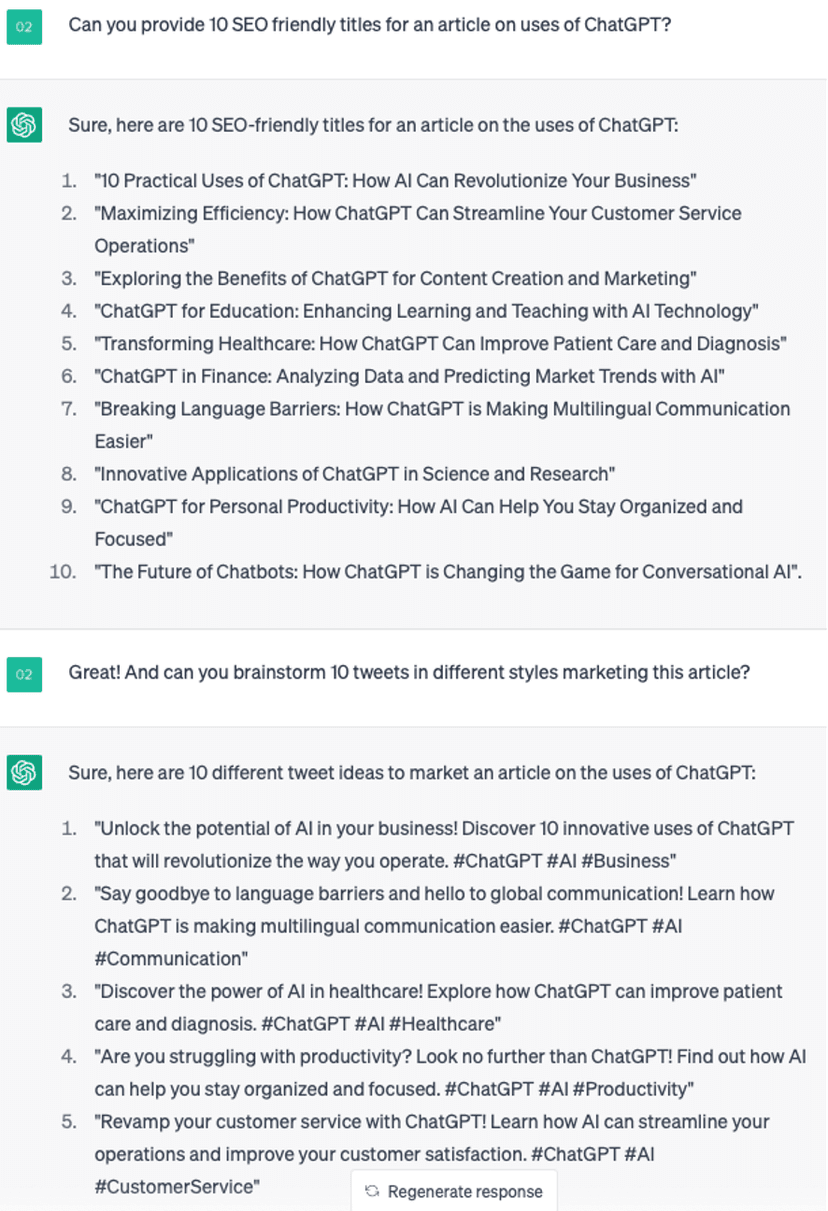
A screenshot of a brainstorming session. Source: ChatGPT
5. Generating customer service emails
ChatGPT can also help automate customer service emails. For instance, it can produce messages that alert customers about known system downtime, upcoming business closures or modified hours for holidays. It can also create sales emails that notify your customers about discounts or other promotions. ChatGPT can produce these emails in a variety of languages as well.
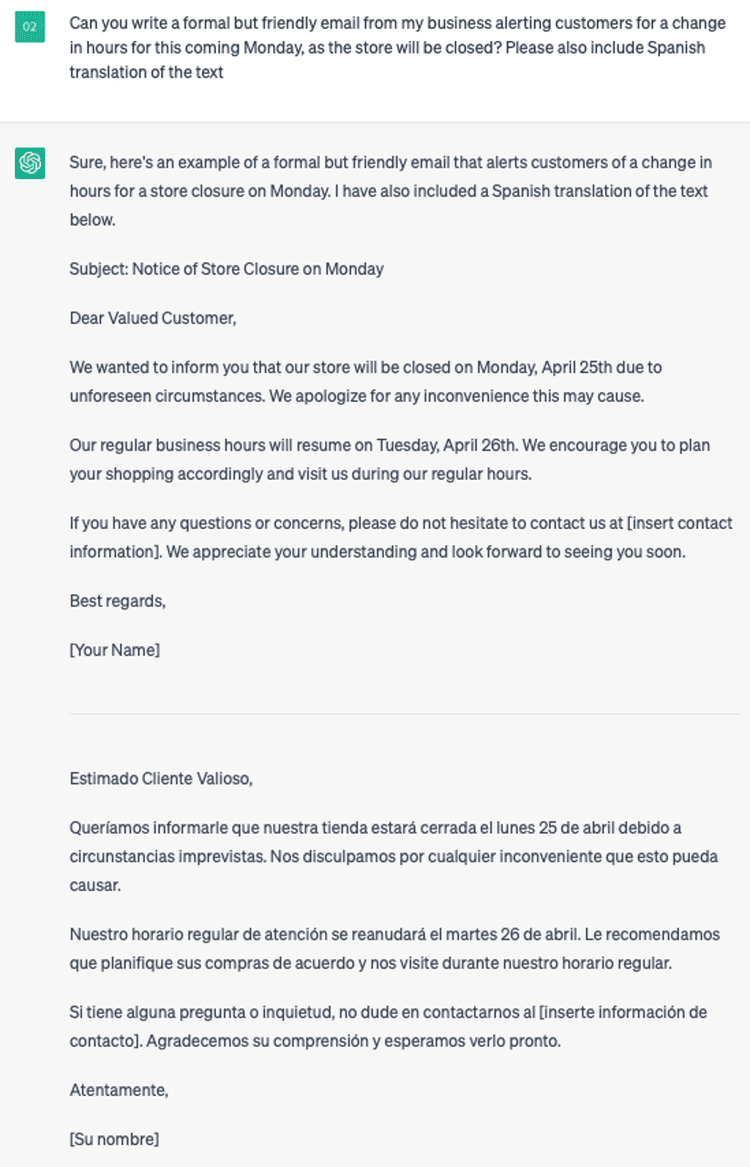
A screenshot of business communications generation. Source: ChatGPT
6. Explaining difficult concepts
One area where ChatGPT shines is in its explanatory power. Because the tool has ingested huge amounts of data, it can answer almost any question to some degree, with the exception of current events. ChatGPT’s data only runs through 2021, so some of its responses about relatively new topics may be wrong or out of date. However, if you consider it as an automated encyclopedia that can explain topics at various levels, it functions remarkably well.
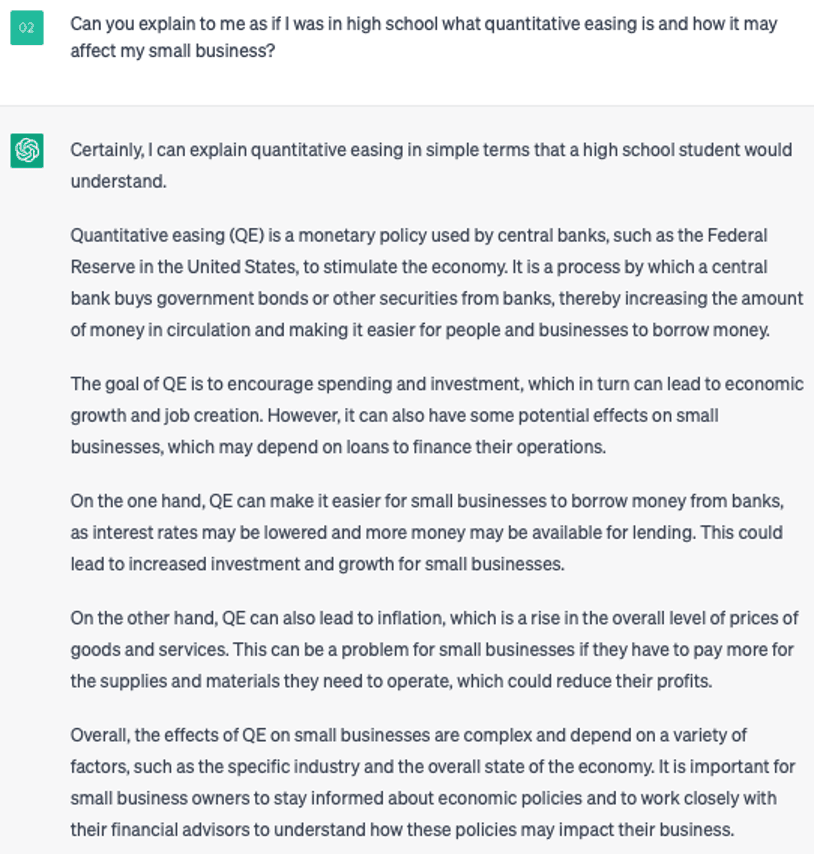
An explanation of quantitative easing and its effects on SMBs. Source: ChatGPT
7. Creating responsive chatbots
For small businesses looking to integrate smart chatbots into their websites, ChatGPT’s API is an excellent consideration. There is no lack of chatbots currently available for businesses to use. However, ChatGPT-powered chatbots have the benefit of using the most cutting-edge AI tools. This technology means ChatGPT can generate responses as opposed to using stock responses that best match a customer’s inquiries. [Read next: The Latest Chatbot Trends]
8. Generating interview questions
ChatGPT is set to shake up many industries, especially HR and hiring roles. One area where the tool can really shine is in helping to develop interview questions. Depending upon how much detail you provide to ChatGPT, it can increase the complexity of the questions to match the role.
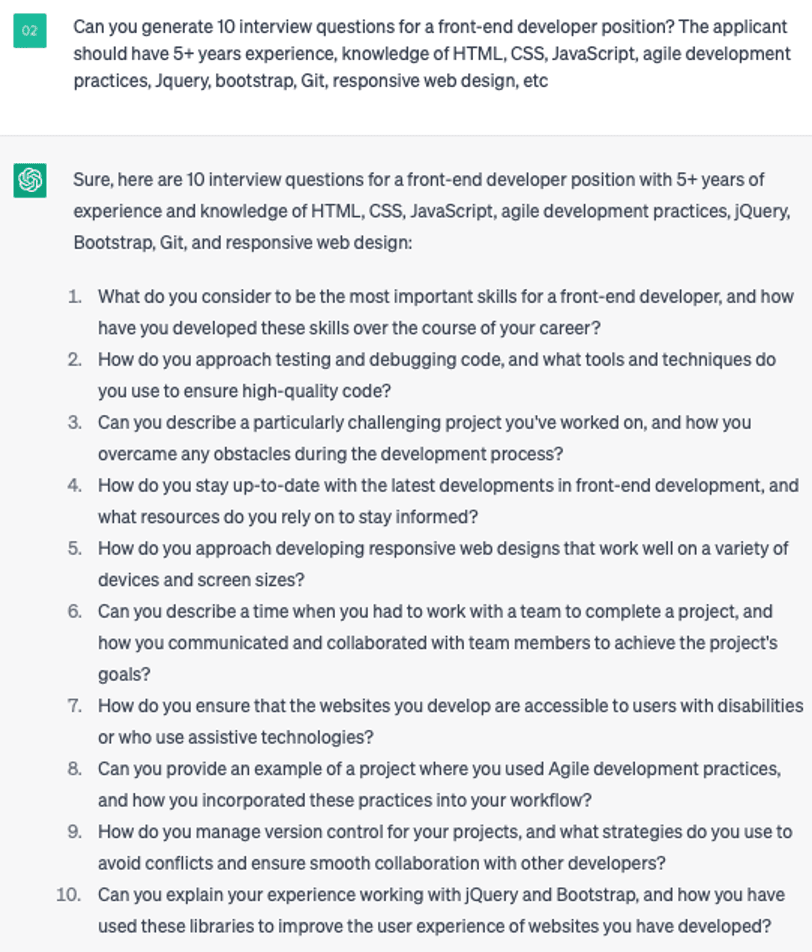
A list of generated interview questions. Source: ChatGPT
9. Helping with web development
Because ChatGPT was trained on information from across the internet, it has learned some amount of coding and web development. While ChatGPT is not capable of fully replacing web developers and designers, it can help generate stand-in web pages. This can be particularly helpful for quickly iterating through various designs to settle on a final layout and feel, as well as providing a starting point for further development.
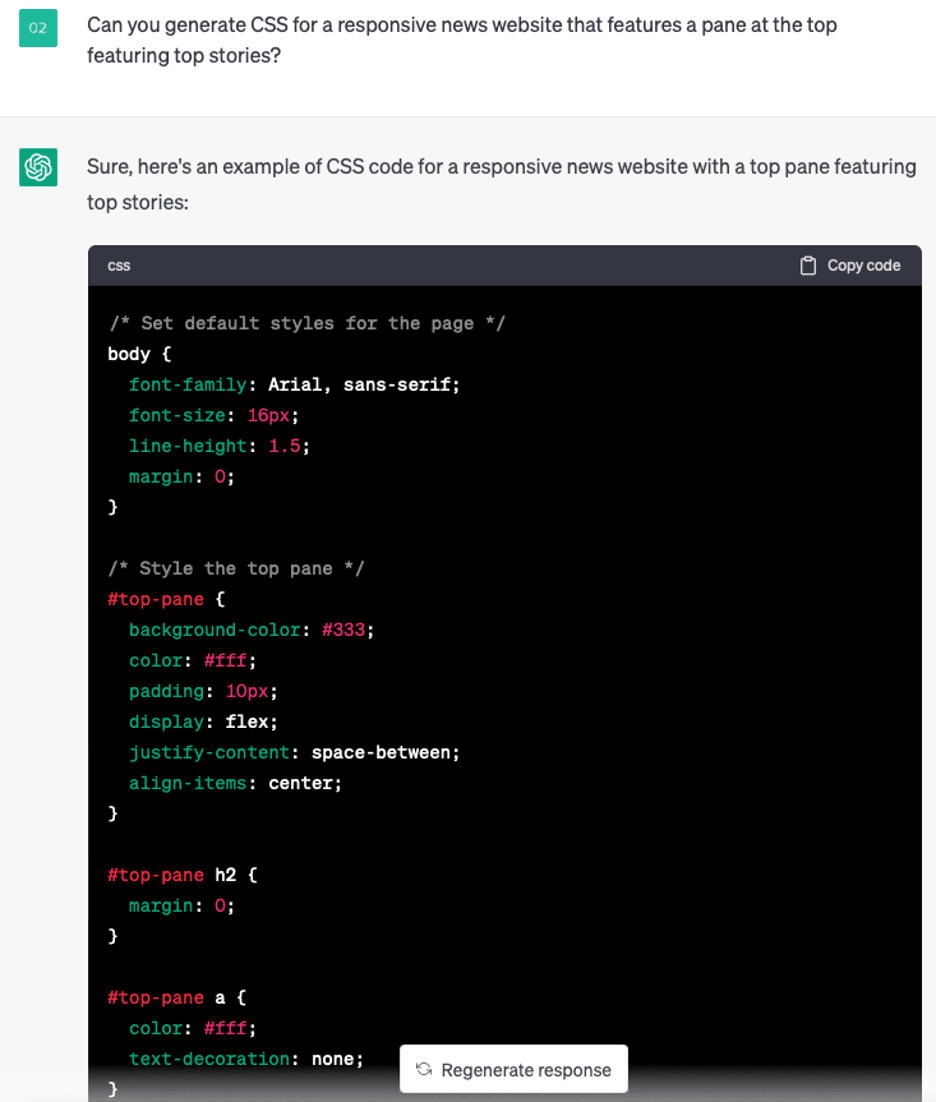
A screenshot of some of the CSS code, which styles a webpage, generated by ChatGPT. Source: ChatGPT
Tips for using ChatGPT for small business
The number of ways to use ChatGPT for your small business is limited mainly by your imagination. The tool can help provide the first steps for multiple different types of tasks. Intelligent use of ChatGPT can free up time for workers to pursue more advanced projects.
However, there are pitfalls to using the tool. Whenever you use ChatGPT for any function, follow these best practices:
- Fact-check. ChatGPT knows a lot about almost everything. Even so, it is not foolproof. Always fact-check anything ChatGPT writes, especially if it’s for outside consumption. Treat ChatGPT’s output as a rough draft.
- Proofread. Like fact-checking, always proofread any output from ChatGPT. While the tool can match different tones, ensure that the tone used matches your brand voice and style.
- Push the program. If you’re not satisfied with an answer from ChatGPT, provide it additional directions and ask it to try again. The tool has a set amount of memory that it can use to rework responses to better match your desired outcome.
- Avoid using ChatGPT to create entire articles. You might be tempted to use ChatGPT to entirely generate articles or online content. However, avoid using ChatGPT for content that will be posted online without modification. Search engines may penalize fully chatbot-written text. Instead, think of ChatGPT as a starting point.
- Check any code produced. Much like with writing, any code produced by ChatGPT should be checked for errors, vulnerabilities or quirks. While ChatGPT is a capable coder, all of its output should be double checked — especially before being put anywhere sensitive, like a payment site.
- Never enter sensitive information. ChatGPT is a third-party service that may store any entered data for future AI training purposes. Entering sensitive data into the program may constitute a breach of privacy regulations, such as the European Union’s GDPR.
ChatGPT FAQs
OpenAI has radically pushed the boundaries of how AI chatbots can function with its ChatGPT tools. The suddenness of the tool launch, the speed of adoption and the alienness of the tool brings a wealth of questions. The following FAQ should address some of the most basic questions about this new tool.
How does ChatGPT work?
ChatGPT is a generative AI chatbot that uses a variety of machine learning techniques and AI methods to learn, understand and produce human-sounding language. What’s going on under the hood of ChatGPT is complex and represents the cutting edge of AI research. Essentially, though, ChatGPT uses two methods called Natural Language Processing (NLP) and Large Language Models (LLM).
NLP involves teaching computers to understand and respond with human language. A lot goes into NLP, but in short, it involves feeding an AI model huge amounts of language text. The model then uses algorithms and statistical analysis to “understand” language. LLMs are AI models that are pretrained on large amounts of textual data. NLPs are used to analyze text pre- and post-output into an LLM.
In sum, OpenAI trained ChatGPT on almost the entirety of the internet. This taught the program language, as well as many additional fields of knowledge.
Is ChatGPT free?
The basic version of ChatGPT is currently free to use after you create an account. This base version is highly capable, but may become unavailable at select times if there is high demand.
OpenAI also offers a paid tier, ChatGPT Plus, which uses a more advanced AI model. This model is meant to have a wider range of knowledge, have better problem solving skills, and is also better able at reasoning. ChatGPT Plus currently costs $20 per month.
For developers, OpenAI also offers a paid API that can integrate with ChatGPT Plus or ChatGPT. The cost of integrations depends upon usage and which tool it is integrated with.
Is ChatGPT secure?
ChatGPT is secure, but by no means foolproof. There have not been any publicly disclosed breaches or attacks on the ChatGPT platform as of this writing. However, the ChatGPT platform itself can pose security risks.
AI tools may ingest and store user information for training purposes. This means any data shared with ChatGPT could be used to train the chatbot in the future. Users should never share any sensitive data with the chatbot, in case ChatGPT either shares that information with other users by mistake or in case there is a breach of the platform.
How accurate is ChatGPT?
ChatGPT is, for the most part, reliable. However, because it was trained on the internet, ChatGPT has ingested a large amount of bias and misinformation. While OpenAI has done considerable work to finetune the model into not providing biased answers or falsehoods, the work has not been perfect.
Additionally, ChatGPT and other chatbots have been known to “hallucinate.” Hallucinations are when a chatbot includes false information mixed in with accurate information in a response.
Due to these risks, it is important to always use ChatGPT as just a starting resource. Be sure to always follow up any research started on ChatGPT with other, vetted sources.
The future of chatbots
AI chatbots have exploded in popularity since OpenAI released ChatGPT publicly in 2022. Since that time, Microsoft has integrated a chatbot with Bing, Google has released Bard, and OpenAI has released ChatGPT Plus, along with the launch of a number of other, lesser-known chatbot services. Adjusting to the new normal of chatbots will take some time. However, if used intelligently, chatbots can help make workers more productive and ease some of the busy work that hangs over every small business.

